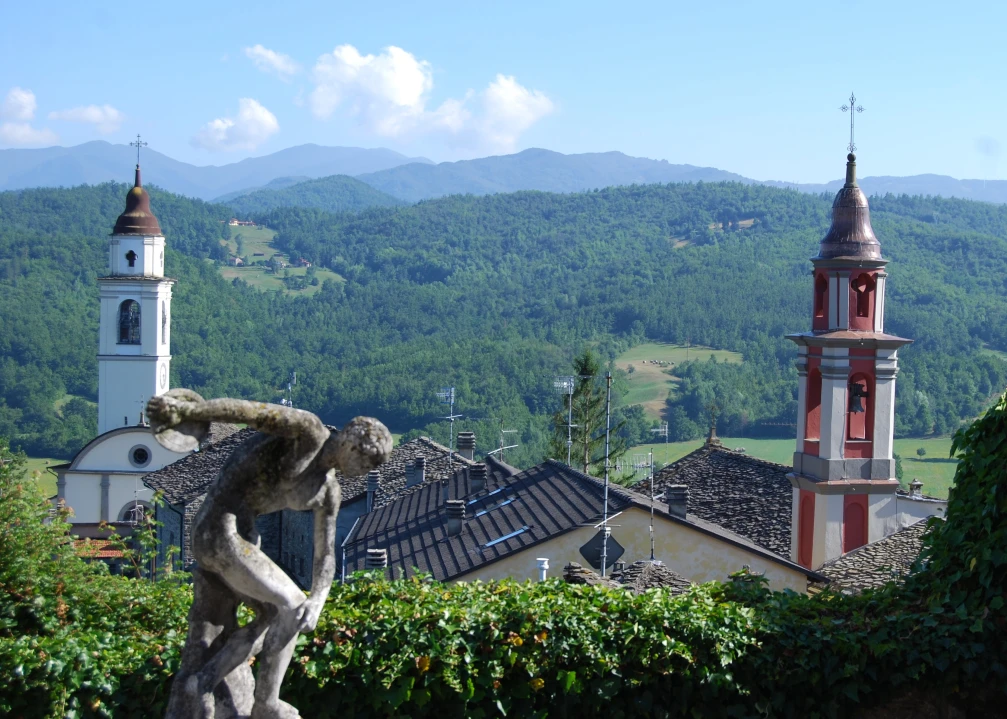Compiano stands on a rocky spur rising on the left bank of the Taro River, in Emilia Romagna but wedged between Liguria and Tuscany. The ancient village is dominated by a castle whose origins are uncertain: restoration work carried out in 1994, however, uncovered buildings dating back to before the eighth century A.D..
In later years the expansion of the manor house was followed by the expansion of the village, which now stretches along the coast in a north-south direction. The first owners of the castle were the Malaspina, but the most representative family of Compiano and the Taro Valley was the next one, the Landi, who from 1257 to 1682 ruled the state to which they gave their name.
The territory acquired political stability and increasing administrative order until it became one of the most important Principalities in the northern part of the peninsula, proclaimed such in 1552 by Charles V, having autonomous jurisdiction, the right to mint and to appoint notaries. At this point the Landi Principality extended between Compiano, Bardi and Borgo Val di Taro. The architect of this incredible fortune was Federico I Landi, who in 1595 saw an opportunity in the marriage between his sister Maria and Ercole Grimaldi, then Lord of Monaco; from then on, the latter's descendants could boast the title of Princes.
It was yet another marriage that determined a decisive moment for the Landi dynasty; in 1630 Frederick II Landi, having no direct male line of inheritance, consented to the marriage between his daughter Polissena and Gian Andrea Doria, leading to the merger of the two dynasties. Having already taken possession of the Borgo Val di Taro area, this situation was taken advantage of by the Farnese family, who had been claiming the fiefdoms of Bardi and Compiano since the beginning of the 17th century, where they settled in 1682, turning the castle into a military prison, which remained so during both the Napoleonic conquest and the revolutionary uprisings of 1821. At the unification of Italy in 1861 the now former Landi State became part of the Province of Parma.
Worth seeing
The Borgo has uphill paved alleys overlooked by noble palaces and tower houses; since 1500 it has been protected by city walls, which also offer a beautiful walk over the valley. Follow the paved street to reach the Piazza, a picturesque terrace on the Taro, near which is the Church of St. John the Baptist, probably dating from the Lombard period, on which major restorations were carried out in the 1700s and inside which there are artistic and sculptural elements of considerable value, such as the Holy Miraculous Crucifix, a wooden sculpture dating from the 15th century. Also noteworthy is the ancient Town Hall and Court of Compiano on whose façade is a lovely 17th-century terrace, and inside which are the ancient prisons, formerly used for administrative offenses. At the apex of the Borgo stands the Castle, its construction probably began from an ancient Carolingian tower around which, in the course of the centuries, the entire manor house was developed, which today stands as a mighty 15th-century structure with 17th-17th-century extensions. With the decline of the Landi State and under the Duchy of Maria Luigia it became a state prison where the Carbonari of the 1821 uprisings were also imprisoned. In 1900 it was used as a women's boarding school and then became a private home again for Countess Gambarotta. It is currently municipal property under private management.
The name
The toponym derives from the Latin term by which the fortification was identified, namely "castrum." Given the presence of an early fortified fortress, the town was called "Castrum cum campo plano," then "Castrum cum plano" which remained "Cumplano" and today "Compiano."
Genius Loci
The "passport of lightness" is the name the Wanderers gave to the meager luggage they carried on their travels. Their activities were diverse; there were sellers of ink, "miraculous" lanterns or ointments, puppeteers, musicians, and "fairgoers with haberdashery." The original epicenter of the Girovaghi was the area of Mount Pelpi, in the Parma Apennines between Bedonia and Compiano; from these areas they left for Europe to sell their creations, play at village fairs and perform with bears, monkeys and camels.
Maria Teresa Alpi, a passionate gatherer, had established in Compiano the Museo degli Orsanti (now moved to another location at the behest of the new owners), and the Festival dei Girovaghi, dedicated to street performers, to those who made the wandering life a way of life, to those who traveled the world on foot or by bicycle, to those who climbed mountains or went to meditate in the desert, and to those who traveled around the countries to sell the strangest things.
The dish of the Borgo
Among the first courses, chestnut gnocchi with ricotta cheese and traditional tagliolini with IGP porcini mushrooms stand out. Second courses, on the other hand, include veal alla Valtarese (roast veal with a side dish of IGP porcini mushrooms) and guinea fowl alla castellana (stewed with flavors from the vegetable garden), but for tradition's sake, local game, such as the classic wild boar stew, should not be forgotten. To conclude, the typical dessert is “latte in piedi”, a kind of milk cream cooked in a bain-marie and sprinkled with caramel.




